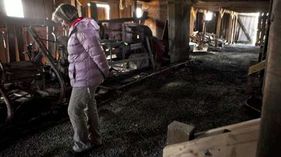Originally published March 23, 2013 at 7:10 PM | Page modified March 23, 2013 at 9:58 PM
At 100, state parks in grim state of disrepair
Washington State Parks turn 100 this month. But not since the Great Depression has the park system been so imperiled.
Seattle Times staff reporter
Photos by BETTINA HANSEN / The Seattle Times
Maurya Broadsword, a worker at Kittitas County’s Olmstead Place State Park, walks through a water-damaged, moth-infested bedroom of the site’s historic home. A worn sign near Chehalis, top, marks the John R. Jackson House, which has started to rot.
A massive December storm took down hundreds of trees at Lake Wenatchee State Park. With staff cuts, cleanup won’t be finished for summer.
Ranger Charles Andrade locks up the renovated lodge at Flaming Geyser State Park in Auburn. For lack of funds to repair utilities, the facility can’t be used.
Photos by BETTINA HANSEN / The Seattle Times
Pam Wilkins, a state parks manager, locks up at the John R. Jackson House in Chehalis. Standing on the porch is former Secretary of State Ralph Munro, who says that by failing to maintain historic properties, the state is violating the trust of families who donated them.
BETTINA HANSEN / The Seattle Times
At Olmstead Place State Park in Ellensburg, a photo shows Clara Olmstead, George Smith and their daughters. Clara Olmstead’s parents homesteaded there in 1875.
BETTINA HANSEN / The Seattle Times
An interpretive exhibit at an old-growth forest near Lewis and Clark State Park in Lewis County has been closed since falling into disrepair about a year ago. Lack of funding keeps maintenance projects like this one on the back burner, officials say.
BETTINA HANSEN / The Seattle Times
Tim Holen, left, his wife, Amanda, and daughter Avery, 2, of Lacey, Thurston County, hunt for sand shrimp at Tolmie State Park near Olympia. Tolmie, like many state parks, no longer offers the educational programs they used to provide.
![]()
Washington state’s park system turns 100 this year, but not since the Great Depression has it been so imperiled.
In a park historic site near Chehalis, Washington’s first courthouse is rotting from the ground up. Outside Ellensburg, at Olmstead Place State Park, heirloom hand-stitched dresses are moth-eaten and the walls water-stained in one of the earliest farmsteads in Eastern Washington.
At Lake Wenatchee State Park, extensive wreckage caused by winter storms is still lying on the ground, with another season about to open. At Flaming Geyser State Park in Auburn, a historic lodge renovated to host weddings — a hoped-for moneymaker for the parks — sits shuttered because there’s no money for needed water, sewer and electrical repairs.
All over the state, many of Washington’s 117 parks, 700 historic buildings and 33 heritage centers and interpretive sites are showing signs of neglect and even abandonment as a result of dramatic budget cuts.
Former Gov. Chris Gregoire and the Legislature in 2011 eliminated most direct state funding for the parks, money which had provided an average of 70 percent of the system’s general operating budget. Instead, the state bet that $30-a-year Discover Passes sold to visitors would pay the bills.
But revenue projections for the pass proved wildly off the mark.
Reducing hours, cutting back maintenance, laying off rangers and reducing park programing only worsened a crisis for a system that was asking visitors to pay more to get less.
Since 2000, the state has shed 12 of its parks, reduced hours at others, and shifted 66 of its 189 full-time rangers to seasonal jobs. Starting in 2009, the state parks have reduced staffing from 595 full-time permanent employees to 395.
The situation has gotten so bad that Gov. Jay Inslee and key state lawmakers say they are considering restoring some state tax dollars to fund the parks.
“The governor is a big supporter of state parks,” said David Postman, spokesman for the governor. He said Inslee’s coming budget proposal will reflect that. “Parks are struggling, and it gets worse every year. We can’t let that go on; it gets harder and harder to get them back where they need to be.”
In a park system in which more than 30 percent of the land base was donated by families, the parks’ state of diminishment and disrepair is unacceptable, some said.
“Families gave this land believing it would be taken care of,” said Ralph Munro, former secretary of state.
“They (the lands) were donated by individual families, who didn't charge us for them, who gave them to the state and entrusted their care and their upkeep and their future in the state. And now we're breaking that trust, we're violating that trust, and that's wrong.”
He spoke standing on the porch of the John R. Jackson House, part of Jackson House State Park in Chehalis. The structure predates Washington's statehood, and the homestead served its early community as a post office, grocery store, tavern, inn and courthouse. Its rotting foundation can be flaked with a finger.
The roots of the parks crisis are in the recession, which reduced the amount of state tax money available for everything in state government. As lawmakers scrambled to pay for basic health-care services for the poor and elderly, and for education, parks seemed an easy target.
It wasn’t the first time.
During Washington’s biggest budget crisis, the Great Depression, Gov. Roland Hartley stopped funding the park system in 1929. For two years, the parks sat shuttered.
It wasn’t until Franklin Roosevelt’s New Deal and the Civilian Conservation Corps brought crews of workers into the woods that the parks were not only rescued but improved.
The stone and wood buildings that grace so many state parks today date from that era, which turned out to be the high-water mark for state-park investment.
With the growing popularity of automobile travel, parks saw the dawn of an era of family recreation that hasn’t quit since, as annual visits exploded from 1.6 million in 1950 to more than 7 million in 1960 to as many as 40 million today.
Most visitors are day trippers, but some camp on Washington’s primo public lands.
Washington has the fourth-oldest state-park system in the country — preceding creation of the national parks by four years.
From saltwater to scab lands, the park system has had something for everybody. In the past, there were guided ranger walks in the woods, lifeguards on the beaches, interpretive guides at the state’s historic sites, expansive campsites with well-maintained facilities — and no entrance fees.
Not anymore. Wrestling with diminishing revenue, state lawmakers enacted the parks’ first parking fees in 2002. Trying to keep parks open, the state first imposed a $5 parking fee. It was replaced in 2006 with a $5 voluntary donation collected with vehicle license fees — next converted to a fee extracted automatically unless drivers chose to opt out.
The amount of state funding for parks continued to crater, from 63 percent of the $149 million total budget in 2007-09 to 18 percent of the $121 million budget this biennium.
The percentage of the agency’s budget coming from user fees did soar from about 25 percent to more than 40 percent between 2000 and 2010. But it wasn’t enough.
As the recession bottomed out, then-Gov. Gregoire announced, while putting her budget together in 2010 for the coming biennium, that the state’s share of the parks budget would have to be supported by user fees.
The Legislature launched the Discover Pass in 2011, charging visitors $30 a year to use state park facilities.
It was a radical step: No park system in the country is so heavily supported by user fees, and the Discover Pass generated only about half the hoped-for revenue. The cutting got deeper.
“It’s sad,” said Tom Pew, who takes care of a swath of parks from Nisqually to Eatonville to outside Chehalis.
In his 31 years with state parks he has watched his job change from primarily providing safe, rewarding experiences for park visitors to cruising the parking lots for Discover Passes on the dashboard and running after emergency maintenance.
“We are just getting by with keeping the campgrounds and the restrooms clean. The heavy emphasis on the collection of the fees, that takes staff time too,” Pew said. “We have less contact with the public, and the contact we do have is in more of a negative manner.
“I guess you could say we have gotten more into a law-enforcement mode on our contacts, from a friendly mode.”
At Lake Wenatchee State Park, storm damage downed so many trees that more than half of the campsites are unusable, with the recreation season fast approaching. Cleanup is slower, with fewer year-round staff to tackle the mess.
Meanwhile, all over the state, portions of trails, scenic overlooks and campgrounds are cordoned off because there is no money to repair or maintain them.
Some parks have been jettisoned by the state. Since 2000, 12 parks have been transferred to local, federal or tribal governments, or closed.
Others, such as Fort Worden at Port Townsend, are in transition as the park system looks for another way to operate them.
Negotiations are under way with a public development authority created by the city of Port Townsend to co-manage Fort Worden, which has more than $89 million in deferred repair and upkeep needs.
“We need partners to help us, and this is one option,” said Daniel Farber, a state parks officials. “They want a lively, effective facility, and if they want to keep it up and see the outcome based on their own efforts, this is potentially good for them and for all of us.”
Some transfers have resulted in cautionary tales. The state used to operate a string of parks along the Snake River, built by the U.S. Army Corps of Engineers as part of its mitigation for construction of Snake River dams.
When the state ran out of money to operate the parks in 2002, it asked the corps to take over, which it refused to do.
Today one park is closed, another operates only a few hours a year when volunteers help, and another is open only seasonally by a concessionaire.
Even state legislators who pushed hardest for a user-fee system say the effort has run aground. This has to be the year for a turnaround, some lawmakers say, and it should be a permanent one.
Rep. Ross Hunter, D-Medina, the chief budget-writer for the House, said funding parks is good for business and the state’s quality of life.
“We are not trying to be Arkansas. We are not trying to drive the state tax system into the ground. We are trying to say what are the right set of purposes that people want, and in my district, people want parks,” he said.
“It’s one of the huge attractions of our state and why we have the high-tech community that is driving the economy. Stiffing the state parks ... Are you serious?”
Lynda V. Mapes: 206-464-2736 or lmapes@seattletimes.com






















